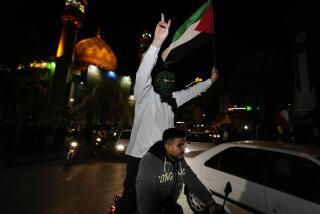Croats Rush to Drain Massive Lake Behind Dam
As water gushed through holes blown into the Peruca Dam by retreating Serb fighters, Croatian engineers scrambled Friday to drain a massive lake behind the damaged structure to prevent a torrent from crashing down on thousands of homes in the valley below.
Confused and conflicting official reports on the prospects for a swift, controlled drainage of the 11-mile-long reservoir reflected the Zagreb leadership’s fear that their military success in recapturing Peruca this week could turn into a political and human disaster if the dam gives way.
Croatian Radio sought to calm fears, claiming that there was no immediate threat that the eroding barrier would rupture.
But a government statement issued after civil engineers visited the structure said it would take weeks to drain the lake and conceded that there was a “realistic danger” of an uncontrolled breach.
By evening, state-run media were reporting that there was “no chance of imminent catastrophe” and that there was no need to evacuate the 20,000 people living in the dam’s shadow.
Meanwhile, fighting continued across hundreds of miles of Croatia and Bosnia-Herzegovina. Foreign aid agencies reported that they were unable to deliver vital supplies to civilians cut off by the persistent fighting.
U.N. officials have expressed increasing despair over the fighting and concern for the safety of the nearly 25,000 peacekeepers deployed in the two former Yugoslav republics.
U.N. Secretary General Boutros Boutros-Ghali has threatened to withdraw his “blue helmet” forces if the combatants refuse to respect any of the numerous cease-fire orders issued by the world body.
In a sign of their growing fears for the lives of their U.N. soldiers, France and Britain have moved naval task forces to the Adriatic, positioning them to help protect or to evacuate their troops.
With U.N. authority waning among the rival factions, many fear that Western mediation attempts may soon cease, leaving no impediment to an all-out war that could spread to Albania, Macedonia, Bulgaria, Turkey and Greece.
Fighting was somewhat reduced from the previous day’s intensity as Croatian soldiers joined in efforts to shore up the dam. But artillery exchanges were reported at most other sites along the nearly 80-mile line of confrontation stretching from the port of Zadar to Peruca with “no drawing back of positions on either side,” said U.N. mission spokeswoman Shannon Boyd.
She described the battle for Peruca as “a stunning bit of irresponsibility” by both Serbian and Croatian forces.
Peruca Dam, the main source of electricity for most of southern Croatia and a strategic pawn in the Serb-Croat war for more than a year, was among the key installations restored to Zagreb’s control over the past week during a Croatian offensive that has drawn international condemnation.
Croatian forces shattered a year-old cease-fire on Jan. 22 to retake the vital Maslenica Bridge and an airport at Zemunik, near the coast, as well as the Peruca complex won in a fierce artillery battle with rebel Serbs on Thursday.
As the Serbian gunmen were forced to retreat from the dam, they detonated some of the thousands of mines they had set at the facility to deter any Croatian move to recover it. The explosions blew huge holes at both sides of the 550-foot-wide dam, releasing water from the vast reservoir that engineers said was progressively undermining the earth-and-concrete wall through “self-erosion.”
Peruca stops up the Cetinje River about 25 miles north of Croatia’s largest port, Split.
The dam was seized by Serbian gunmen during their 1991 armed rebellion against Croatian independence and was used over the following months as a weapon to threaten the Croatian population living downriver. Militant Serbs closed its gates in the autumn of 1991, allowing so much water to collect behind the structure that those below it feared that it might give way.
U.N. peacekeeping officials negotiated a lowering of the lake a year ago and took over responsibility for the whole facility in September, 1992. But they failed to defuse the Serb-laid mines, and the foreign troops fled their stations Thursday when Serbs re-entered the complex.
Serbian leaders in the rebel stronghold of Knin claimed that Peruca was damaged by Croatian artillery, but the strategically placed punctures appeared unlikely to have been made by randomly fired shells.
The 12-nation European Community appealed to Croatian President Franjo Tudjman to end his country’s 8-day-old campaign to recover territory lost to the Serbs in 1991. But Tudjman has said he will withdraw from the disputed areas only after Serbian gunmen there are disarmed so that expelled Croats can safely return.
A U.N. peacekeeping plan drafted by former Secretary of State Cyrus R. Vance was supposed to lead to restoration of civilian order in the Serb-occupied region, known as Krajina, but the transition stalled after U.N. troops arrived, allowing the rebels to retain their exclusive domain.
In Bosnia, continued clashes were reported between Croatian and Muslim forces in the center of the country, and Serbs stepped up shelling of the capital, Sarajevo.
Bosnian Croats have sealed off all overland aid routes to central Bosnia, choking off live-saving food deliveries, the Office of the U.N. High Commissioner for Refugees in Geneva reported.
Nearly 2 million people have been routed from their Bosnian homes by fighting and the Serbian practice of “ethnic cleansing.” Government officials contend that 200,000 have been killed in the republic since Serbs began a siege in April.
The rebels in both Croatia and Bosnia were armed and instigated by Serbian nationalists in Belgrade, who want to link as much land as possible from the ruins of Yugoslavia into an expanded Serbian state.
More to Read
Start your day right
Sign up for Essential California for news, features and recommendations from the L.A. Times and beyond in your inbox six days a week.
You may occasionally receive promotional content from the Los Angeles Times.







